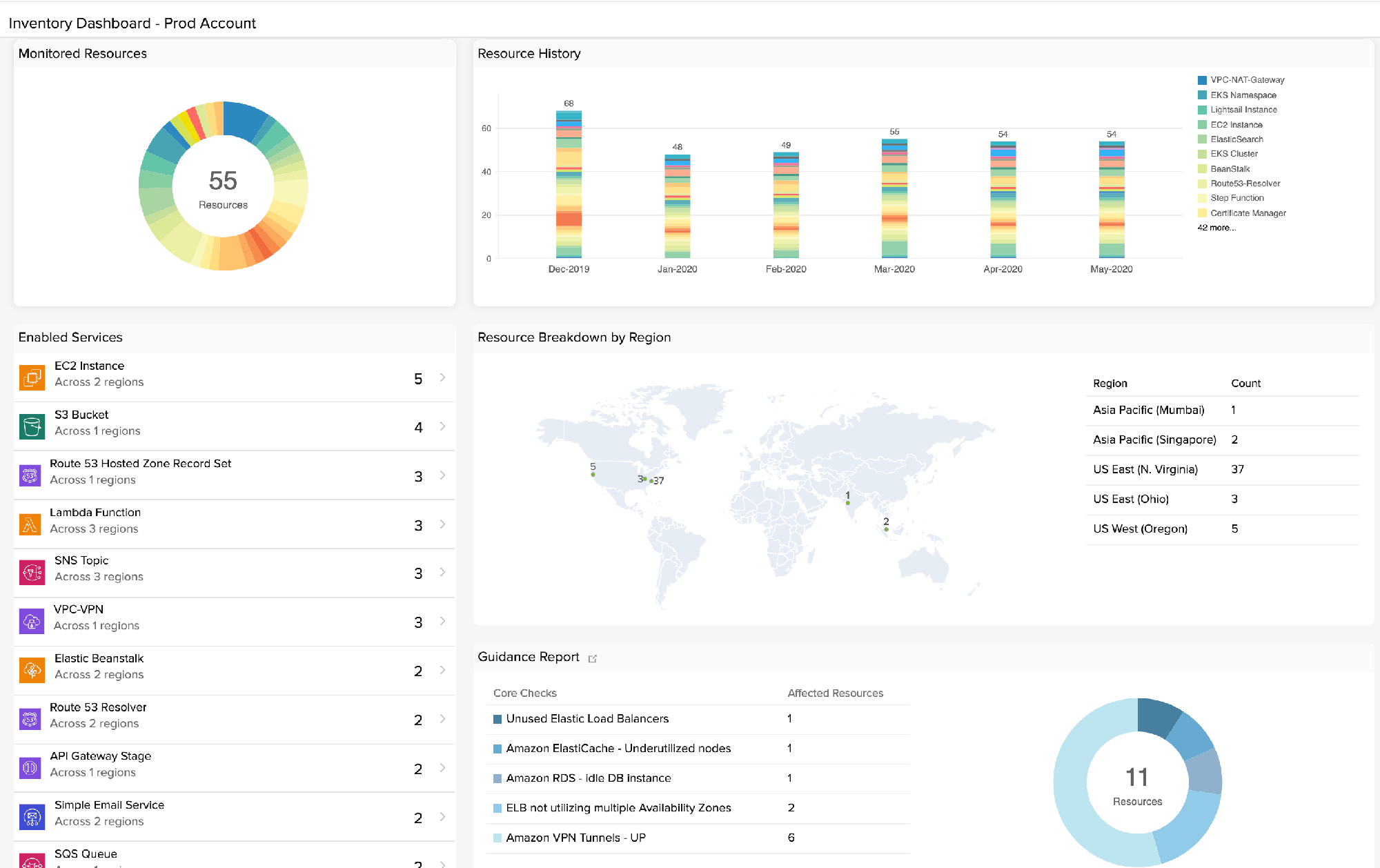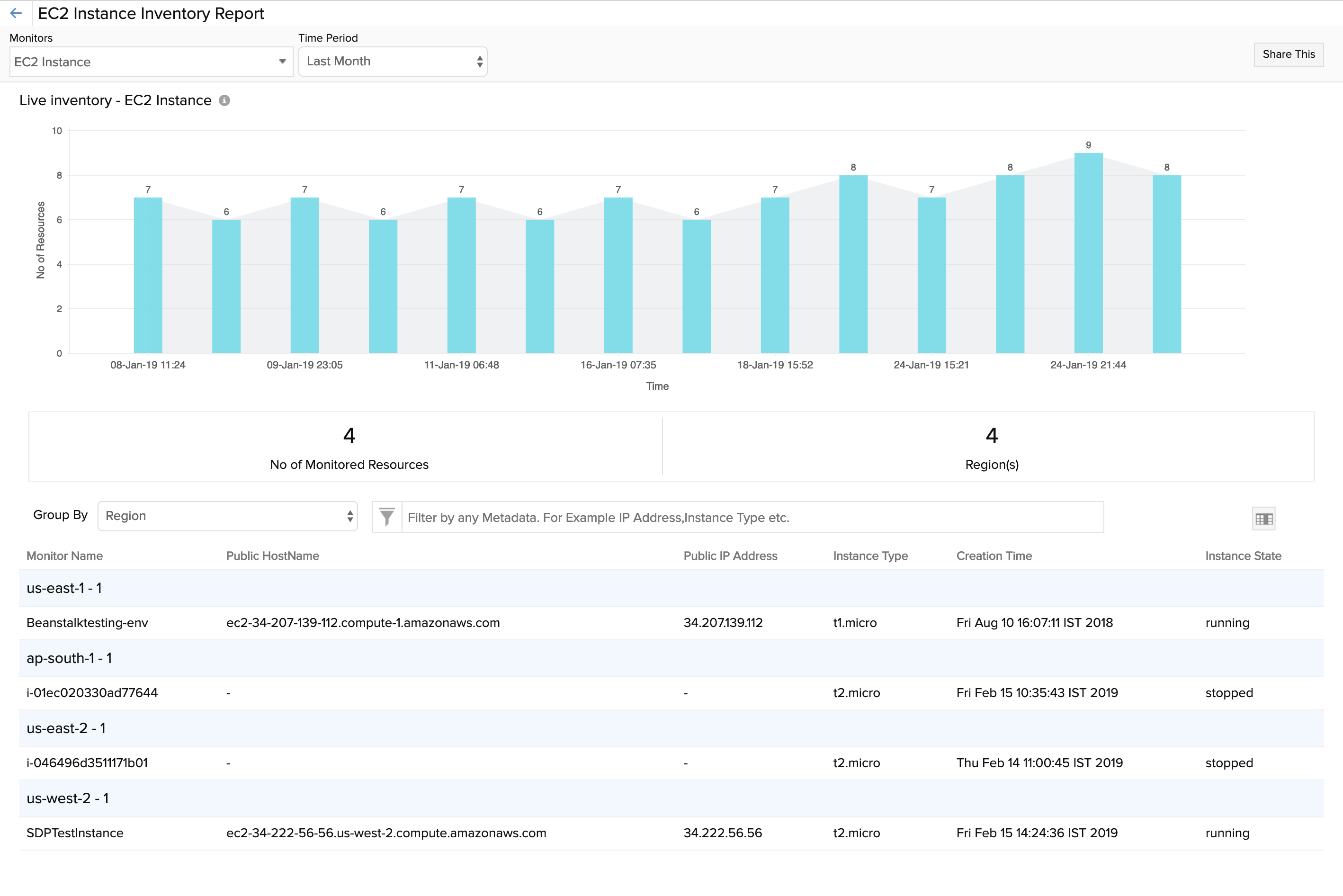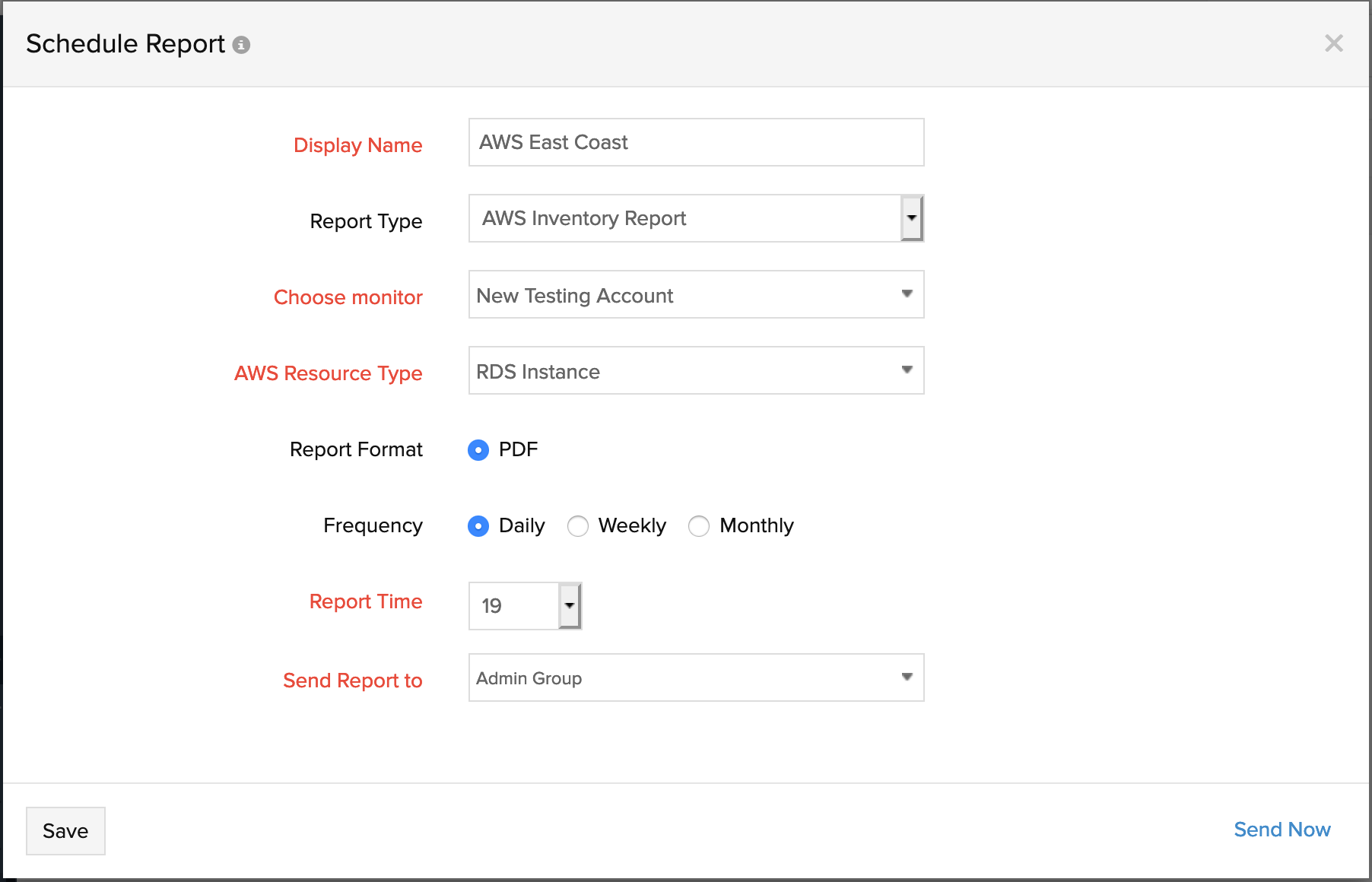Introduction to AWS Inventory Dashboard
The AWS Inventory Dashboard offers a unified platform to view the overall resource count and resource metadata of your monitored AWS account, including Control Tower parent and linked accounts, based on multiple configurations such as configured regions or time. The dashboard provides a breakdown of the active monitored resources (such as EC2, RDS, DynamoDB, ELB etc.), resource history, detailed inventory report for enabled services, region-based resources, and guidance report for your AWS monitors.
Prerequisites and accessing Inventory Dashboard
At a minimum, you must have the below-mentioned requirements to access and use the AWS Inventory Dashboard.
- Evaluation or Paid Site24x7 subscription account.
- Amazon Web Service (AWS) monitor.
To create an AWS monitor, enable access to your AWS account via IAM user creation or cross-account IAM role and connect your AWS account with Site24x7. Learn more.
You can access your AWS Inventory Dshboard by following the steps below:
- Login to Site24x7.
- Navigate to AWS tab > Select Inventory Dashboard listed under your AWS account.
Data sources
Based on the polling fashion, API requests are sent to a number of AWS read-level service functions like DescribeInstances, DescribeVolumes, at predefined intervals to collect, list and track resource count and usage for all supported AWS service types (such as, EC2, RDS, DynamoDB, ELB, SNS, EBS, S3, and more).
Features and widgets
The Inventory Dashboard's GUI has a number of widgets and features that portray data based on the underlying AWS services. Following are the common widgets:
- AWS Monitored Resources
- Resource History
- Enabled Services
- Resource break-down by Region
- Guidance Report
AWS Monitored Resources
The count of all the active monitored AWS resources associated with your AWS account is displayed based on their underlying service, along with a donut chart. The Donut chart displays the number of monitored AWS resources as rings. Here each ring represents a type of monitored AWS service, you can hover over the ring to know the contribution of that service to the whole count. Every service that's checked for discovery in the "Services to be discovered" field during AWS account monitor creation will add a new ring to the chart.

Resource History
The Resource History widget uses a stacked bar chart to portray the different AWS services configured during a month. Every AWS service has a unique legend, which could be used to identify the AWS resource type. Also, each stacked bar will show you the total number of AWS resources configured during that month.
Enabled Services
You can view the real-time breakdown of your AWS services in your monitor using the "Enabled Services" widget. It lists out all the AWS services, count of individual services and also the number of AWS regions they are scattered across. Additionally, you can get an indepth report for every resource by clicking the service icon inside the widget. Learn more about the Service Inventory report.

Resource break-down by Region
You can visualize your AWS services based on the AWS regions they are configured in. Access the "Resource Breakdown by Region" widget to view a global map showcasing the actual service count at individual AWS regions (where you've configured your AWS resources). Additionally, the region-based service count split-up data is displayed in a table.
Guidance Report
Site24x7's Guidance Report for Amazon Web Services provides a set of best practice checks to help you save money, increase performance and reliability. The Guidance Report widget highlights the core checks and affected resource count based on the configuration of your AWS monitor. Learn more about Guidance Report.
AWS Service Inventory Report
The AWS Service Inventory Report gives a quick insight into how your different AWS services have been operating during a selected time range. The top section of the AWS Service Inventory report has a filter that allows you to select the AWS resource and the reporting time granularity. Additionally, you can also view the Control Tower parent and linked account details by selecting the applicable option from the Report Level field.
The report has multiple widgets such as the Live Inventory section, monitored resource count, and number of regions. At the bottom of the report, you can view detailed metadata of your resources of a selected type.
For example, let's say you've selected EC2 Instance as your default resource type and Last Month as your Time granularity. The Live Inventory widget for EC2 Instance will show the actual changes to the monitored EC2 instances from the date and time when it was first configured in the account. The data is plotted on a bar chart with Y axis showing the number of EC2 instances and X axis defining the date and time stamp when the EC2 metric collection was activated or deleted. The suspended resources are not included in the graph. Additionally, you can view the number of enabled EC2 instances and the regions that they are scattered in from the other widgets.

Additional inventory information
The detailed inventory information for the selected AWS resource type will be shown at the bottom of this report. Example, If you've selected EC2 instance type, you'll shown all the monitored EC2 instances and their corresponding metadata and configuration information organized in columns. You can also use the column filter to add or remove metadata from the view.
Share and schedule Inventory Report
Export: You can export your AWS inventory dashboard as a PDF file.
To export, follow the steps below:
- In the AWS inventory dashboard pane, select the
 icon
icon - Select the Export PDF option
- Once the file gets downloaded, open it an appropriate PDF reader like Adobe to analyze resource usage or share data.
Email: You can also share the dashboard with team members using the Email option.
To share via Email, follow the steps below:
- In the AWS inventory dashboard pane, select the
 icon.
icon. - Select the Email option
- Configure the Email address and the Subject field as per your discretion and click the send button.
Schedule Inventory Report
You can schedule your AWS Inventory Report and share it with your desired users over email on a daily, weekly, or monthly basis. Follow the steps below to schedule an Inventory Report:
- Log in to Site24x7. Navigate to Admin > Report Settings > Schedule Reports > Click the Schedule Reports button.
- Fill in the following fields to schedule your AWS Inventory Report:
- Display Name: Enter the report display name.
- Report Type: Select the applicable AWS Inventory Report from the drop-down list.
- Choose Monitor: Select the desired AWS monitor from the drop-down list.
- AWS Resource Type: Select the AWS resource type to share detailed inventory information specific to the chosen resource.
- Report Level: Select the desired report level. This field is available only for Control Tower accounts, and the available options are Parent Account and Linked Account.
- Report Format: You can only share the report in PDF.
- Frequency: The frequency of the report can be set as daily, weekly, or monthly.
- Reporting Period: Select the time range for the data to be included in the scheduled report.
- Time Zone: The time zone in which the scheduled report will be sent.
- Reporting Time: Based on your set frequency, define the exact date and time when you want the report to be sent.
- Send Report to: Select the user group with whom the report must be shared.
- Once the details have been furnished, click Save. Alternatively, trigger a report instantly by clicking Send Now.

